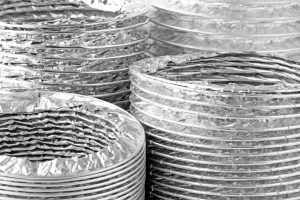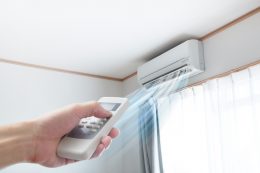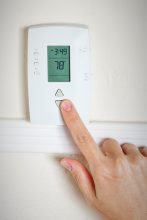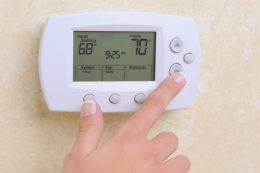Springtime Air Filtration: The Latest in Air Purification Technology for Allergy Sufferers
For allergy sufferers, springtime isn’t simply about the joys of warmer weather. It’s about asthma, hay fever, watery eyes and sinus issues. Seasonal allergies are common, affecting about 50 million people in the U.S., according to the Asthma and Allergy Foundation of America, and poor indoor air quality is one the top five environmental health risks identified by the Environmental Protection Agency. Although you can’t keep yourself in a bubble all season, you can take steps to rid your home’s air of as many allergens as possible using the latest in air purification technology.
Types of Filtration Systems
The two most common types of filtration systems are whole house air filters and portable air filters. Portable filters clean the air in a single room while whole house filters, installed in the HVAC ductwork, can handle an entire home.
Portable systems are pricier, ranging between $50 and $850, with an annual operational cost of up to $200. Whole house filters have a lower upfront cost since they work with existing HVAC systems, but since they require a new filter every one to three months, these costs can add up over a long period of time. Whole house systems must meet certain installation requirements, and, depending on type and size, most cost between $20 and $80.
Types of Air Filters
One way to understand the efficiency of a filter is to look for the minimum efficiency reporting value (MERV) rating, which measures how well it removes airborne particles. MERV scores range from 1 to 20. The higher the score, the better the filtration.
- Fiberglass filters are the most common and comprised of layered fiberglass fibers that trap large particles. These are inexpensive but not the best for allergy sufferers, scoring between 1 and 4 on the MERV scale.
- Polyester and pleated paper filters trap 80 to 95 percent of particles 5 microns and larger. They rate between 8 and 13 on the MERV scale.
- High-efficiency particulate air (HEPA) filters remove 99.97 percent of all particles above 0.3 microns, catching mold spores and even bacteria and viruses. Many HEPA filters have a MERV rating of 14 to 16.
- Electrostatic filters feature self-charging electrostatic cotton/paper fibers that attract and trap small particles using static electricity. There are disposable and permanent options that have MERV ratings that range from 1 to 4.
New Air Filter Technology
These newer filters feature some of the latest air conditioning technology in the industry.
Ultraviolet Air Purifiers
These filters kill airborne particles — including germs and mold — with rays of ultraviolet light that incinerate them as they pass, doing away with traditional filters that need replacement. You can use these pricey systems in either residential HVAC systems or portable purifiers, but be aware that they don’t catch many common allergens such as dust.
Ionic Air Filters
These use negatively charged ions catch even the very smallest air particles, and they are extremely quiet. On the downside, they don’t trap larger irritants like dust, and the ionized particles land on surfaces in the room and can easily find their way back into the air. They also emit ozone, which can irritate sensitive lungs.
What’s Right for You?
Using existing HVAC systems to install a more efficient air purification system is a cost-effective choice if you’re looking to improve your long-term indoor air quality. Choosing the best filter depends on the size and capacity of your HVAC system and your needs as an allergy sufferer. Look for high MERV ratings, and consider the pros and cons of each filter type.
Don’t let allergy season take you by surprise. Get your home springtime ready now. The professionals at Cox Heating & Air Conditioning can work with you to improve your home’s indoor air quality by helping you choose the best air filtration system for your needs.
Things to Consider When Closing Vents in Unused Rooms
Sometimes what appears to be a good idea for saving energy may not work so well. That’s the case when closing forced air heating and air conditioning vents (registers) in unused rooms in your house or commercial building. Instead of helping, this practice may increase utility bills and damage heating ventilation and air conditioning (HVAC) systems.
A home HVAC system generally has one register and one fresh air return per room. If you close the register but leave the return open, the return’s duct creates a suction. It draws in outside air through leaks surrounding exterior doors, windows and electrical outlets. In winter, this means extra cold air to heat. In the summer, the infiltration of extra air increases cooling costs.
How to Set Your Thermostat Before You Leave for an Extended Summer Vacation
Getting ready for a serious getaway? You know you can lower your utility bill by adjusting the thermostat for short trips, but what about longer ones? Though the basic principle applies, there are a few issues to be aware of first. Here’s a quick rundown to keep you on the right track:
Benefits of Adding Thermostats to Different Areas of Your Home
One of the big buzz words right now in HVAC is zoned heating and cooling. It’s being touted as a great way to save energy by only heating the areas being used. But what is it and how well will it work in your home? Let’s take a look.
How Do You Know When to Have Your Air Ducts Cleaned?
When you’ve had your HVAC system running for a while, you may begin to wonder when it is time to have your ductwork thoroughly cleaned. Is there dust puffing out of the vents when your system kicks into operation? What about dust or 
Reasons and Remedies for a Dusty Home
Have you noticed that your home has been getting dustier than usual or that it takes more work to keep up? This is often due to issues in your HVAC system. Let’s take a look at common issues that cause a dusty home and how to fix them.
What Is a HERS® Score and Why Does It Matter?
When you’re looking at a home, the HERS score may come up as a point of discussion or negotiation. But what does it mean overall? The Home Efficiency Rating Standards (HERS) looks at the overall energy efficiency of a home, whether existing or new construction. Here are a few things about HERS and why it matters to you and your household.
Improve Your Air Quality With These 3 Steps
We’re always told to “take time to smell the roses.” But when you have allergies, asthma or other respiratory problems, that can be difficult at best. When you spend most of your time indoors, indoor air quality is of vital importance to your health and comfort. But how do you ensure that your indoor air is being treated to get the best possible quality? Easy — by following these three simple steps:
Westchase FL Air Conditioning Repair & Service
If you are looking for reliable HVAC specialists to take care of your HVAC needs, then contact Cox Air Conditioning & Heating in Clearwater, FL.
Geography
Westchase is an unincorporated community in Hillsborough County, Florida. Located between Tampa and Clearwater, it is bounded by the communities of Keystone, Oldsmar, Town ‘n’ Country and Citrus Park. Westchase encompasses an area of 10.8 square miles, 10.7 of which is land. The community sits at 16 feet above sea level.
History
Founded in 1991, Westchase is comprised of 28 villages or neighborhoods, some of which are divided into smaller subdivisions. The community is governed by the Westchase Community Association which is comprised of one voting member from each village, neighborhood and subdivision. Many neighborhoods have a website, and civic participation is encouraged via residents attending website committee meetings or by providing material for the website.
Demographics
Westchase is a Census Designated Place, a populated area that does not have a separate municipal government but resembles incorporated areas in every other respect. In the 2010 census, Westchase recorded a population of 21,747 with a population density of 2,203 people per square mile.
There are 9,244 households in Westchase; the average size is 2.55 members. The median resident age is 36.8, somewhat younger than the median age of 41.3 for the state. Cultural composition includes 80.5 percent white, 15.5 percent Hispanic and Latino and 5.3 percent African-American.
One of the wealthiest areas of Hillsborough County, Westchase reported a median income of $88,964 per household in the 2010 census. Almost 55 percent of the population works in the professional, financial, business or management sector. Most residents commute to work.
Area Attractions
Westchase features convenient access to three shopping malls, nature trails, two town centers and a public golf course. Travel and Leisure ranked it the 26th coolest suburb to visit in 2010.
West Park Village is a vibrant community within Westchase. A walking community with a populace of diverse ages, West Park Village offers access to restaurants, boutiques, village greens, summer concerts and nightlife. The distinct look of the village was inspired by the well-known Hyde Park in South Tampa.
Westchase is home to Tampa Bay Downs, a nationally known American Thoroughbred horse racing track. From December through May, visitors can enjoy live racing action on the one-mile dirt oval. Card-game enthusiasts wishing to take a break from the racing action can try their luck at the Silas Poker Room. In addition to the attractions in Westchase, nearby Tampa offers a multitude of museums, art galleries, parks, aquariums and historical centers to visit.
Climate
Westchase has a humid, subtropical climate. Summer temperatures in Westchase average slightly over 90 degrees, with a range of 50 degrees to 90+ degrees. Temperatures in December and January average 60 degrees and range from 50 degrees to 70 degrees.
Cox Air Conditioning & Heating in Westchase, FL
For 45 years, the professionals at Cox Air Conditioning & Heating have served homeowners and businesses in Hillsborough and Pinellas counties. A full-service HVAC contractor in West Florida, Cox specializes in heating and air conditioning repair, service and installation. The technicians at Cox are also experts at solving ventilation and indoor air quality problems. Our service technicians are available 24/7 to handle emergency heating and air conditioning repairs. When it comes to air conditioning repair, service or installation for your home or business, the Cox team is the one to call.
St. Petersburg FL Air Conditioning Repair & Service
If you are looking for good quality air purifiers to improve the indoor air quality of your home, contact Cox Air Conditioning & Heating located in Clearwater, FL.
History
Founded in 1888 by Peter Demens and John C. Williams, St. Petersburg was incorporated in 1892. It is named after Saint Petersburg, Russia, Demens’ childhood home. Industry began in 1899 when Henry W. Hibbs established a wholesale fish business and began shipping fish. The population exploded in the 1960s and ’70s when the city became the retirement destination for many Americans from the Midwest and has grown to 244,769.
Geography
Located in Pinellas County on the western coast of Florida, St. Petersburg sits on a peninsula between the Gulf of Mexico and Tampa Bay. Often referred to as St. Pete, it is the second-largest city in the Tampa Bay Area, which includes Tampa and Clearwater. St. Petersburg measures 137.6 square miles — 75.9 miles of water and 61.7 miles of land. It connects to Tampa on the east via bridges and causeways, to Bradenton on the south via the Sunshine Skyway Bridge and connects on the north to mainland Florida.
Demographics
The fourth largest city in the state, St. Petersburg has a population density of 3,964.4 people per square mile. The median age of residents is 41.6. Inhabitants are 68.7 percent white and 23.9 percent African-American.
In 2011, top employers in the city included companies in the medical, banking, electronics and energy sectors. The city is home to several secondary education institutions. The median household income is $44,510.
Several historic districts comprise the core of St. Petersburg. Historic Kenwood features more than 2,000 historic buildings and includes Grand Central district, which is known for its art community. Old Northeast and Roser Park are also designated U.S. historic districts.
Attractions
A vacation destination for tourists, St. Petersburg has something for everyone. The Shops at St. Pete is an open-air shopping complex located in downtown St. Petersburg. It offers fine dining and retail outlets that cater to mid- to upper-class patrons. Jannus Live is an outdoor music venue located in the downtown historic district.
St. Petersburg is home to museums, historical centers and art galleries. Citing its vibrant art scene, American Style magazine rated St. Petersburg the best mid-size city in 2011. Visitors can take in theatrical productions and the Florida Orchestra, visit a botanical garden and aquarium, and enjoy kiteboarding and boat rides. The Tampa Bay Rays, a Major League Baseball team, calls St. Petersburg home. Other sports attractions include professional rugby, soccer and auto racing.
Climate
With 360 days of sunshine each year, St. Petersburg is nicknamed The Sunshine City for good reason. Average annual temperatures range from a high of 81 to a low of 65. Winter temperatures range from 54 degrees at night to 74 degrees by day; summer temperatures average 91 and 77. The humid subtropical climate contributes to 45.8 inches of annual rainfall.
Cox Air Conditioning & Heating in St. Petersburg, FL
Since 1958, the Cox team has provided residential and commercial air conditioning repair services for St. Pete and the surrounding communities. As a full-service HVAC contractor, Cox Air Conditioning & Heating delivers heating and air conditioning repair, installation and services as well as products to improve indoor air quality. As a Carrier Factory Authorized Dealer, Cox Air carries superior quality products that are energy efficient and long-lasting. The company’s heating and air conditioning repair technicians are NATE certified and the best in the business. As part of its commitment to total customer satisfaction, Cox provides 24-hour coverage for emergency repairs. Customers in St. Pete and the surrounding area can rely on the Cox team for all of their total comfort needs. Have A Question About HVAC? We Are Here to Help!













Recent Comments